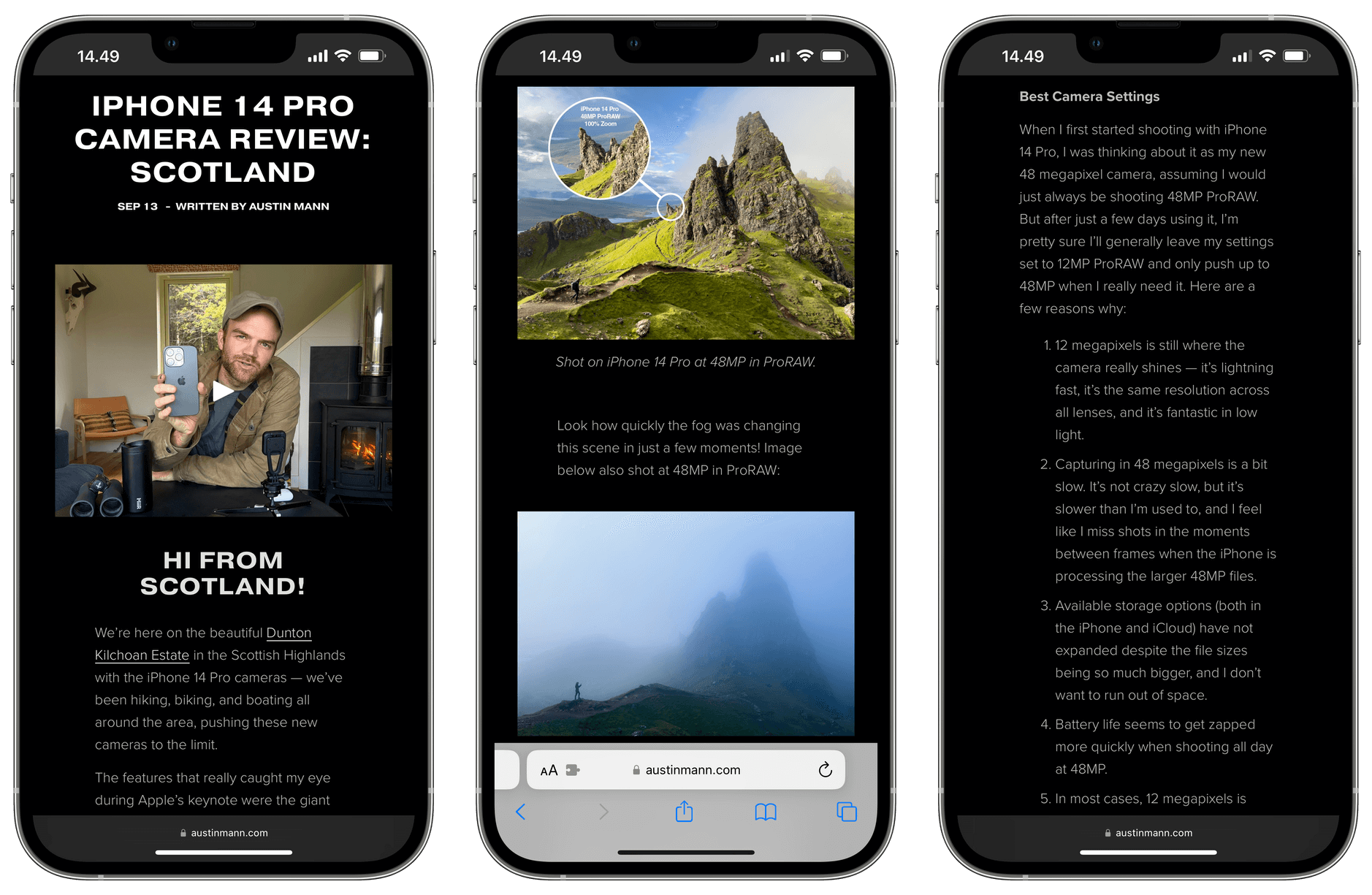„iPhone 14 Pro Camera Review: Scotland“

Als professioneller Fotograf hat Austin Mann einige aufschlussreiche Anmerkungen zu den neuen iPhone-Kameras – so wie jedes Jahr.
I found the sharpness to be favorable on iPhone 14 Pro, but I do feel many of the images I’ve shot are a bit too processed and/or over-sharpened. When this happens, I’ve been bringing the ProRAW files into Lightroom CC and adjusting the “Apple ProRAW” profile slider to the left to reduce the HDR/sharp look if it’s too much for me.
Aber natürlich prägt auch ihn sein Job; die meisten Nutzer_innen von iPhones stehen nicht vor seinen Herausforderungen.
Offloading photos/videos via Lightning cable is another story. I’ve had some serious pains trying to transfer content from my iPhone to my MacBook Pro. […] Once I finally did get the files onto my Mac, viewing the 48 MP ProRAW files in Apple Photos was pretty slow (it takes a long time to preview or zoom to 100%), so I decided I would use Image Capture to import files to the Finder and then view them in Adobe Bridge. This process was simple and direct, but then when I get the DNG files in Bridge, they all looked super dark because the ProRAW profile wasn’t loading there. I had to abandon this method.
Die überwältigende Mehrheit aller Nutzer_innen stehen nicht vor einem solchen Arbeitsablauf; sie bearbeiten Fotos direkt auf dem Telefon. Die Übertragung und das Management von Dateien sind eine absolute Ausnahme.
Das ist keine Kritik am sehr lesenswerten Artikel, es ist vielmehr ein Hinweis an Apples eigene Ansprüche solche Pro-Arbeitsabläufe (voller Stolz) abzubilden.
Tim Cook drückte es auf dem „Far out“-Event so aus:
Products that are intuitive and easy-to-use, that have a unique integration of hardware and software, and that are incredibly personal. […] They’re always with you, whenever and wherever you need them, and are designed to work seamlessly together. On their own, each is industry-leading. Together, they provide a magical experience.
Eine schnellere Datenübertragung wäre dafür wünschenswert – insbesondere für die mächtigen ProRAW-Videos. USB-C wird hier mittelfristig helfen, aber selbst wuchtige DNG-Fotodateien von jeweils 80 Megabyte überspielt man inzwischen mühelos mit AirDrop.
Ich bin mir sicher: Austin Mann weiß das. Deshalb verstehe ich seine nuancierte Kritik am „Digital Workflow“ vielmehr als Frage nach einer Pro-Software für Fotos – einen Nachfolger für Aperture, neben Final Cut, Motion, Compressor, MainStage und Logic.
Vergessen wir nicht: Apple ist der weltweit größte Kamerahersteller mit einem jährlichen „Shot on iPhone“-Wettbewerb. In Cupertino sitzt ein Pro-Workflow-Team. Die pfeilschnellen A-Prozessoren feuern mittlerweile auch macOS an, und Apple beteiligt sich aktiv an der Erweiterung von verlustfreien Dateiformaten.
Ich empfinde daher die Frage nach einer Pro-Foto-App – die ich Austin Mann ganz unverschämt in den Mund gelegt habe – als sehr berechtigt.